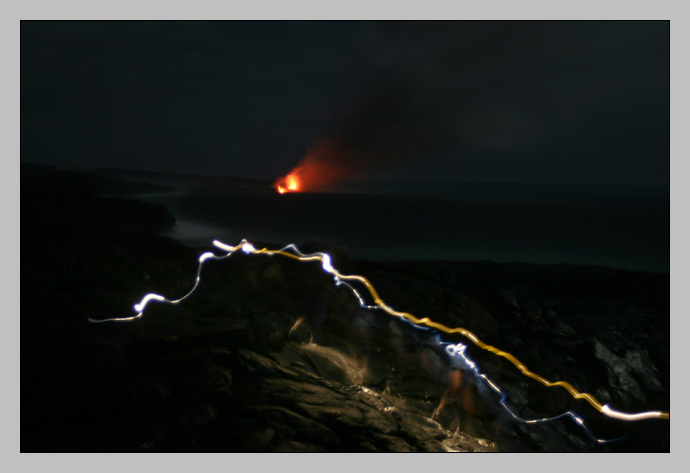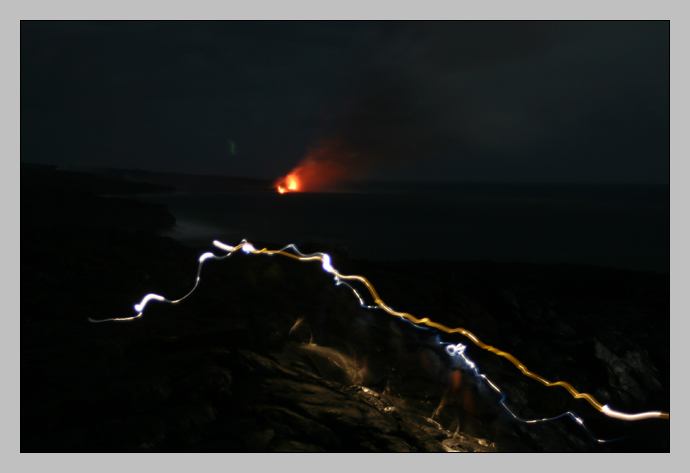
The great tourist myth of Hawaii, perpetrated by all the television travel documentaries, is that you’ll see rivers of flowing lava. Indeed you will, if you go to any of the museums with video display terminals. Apparently, the really fantastic displays occur, oh, every ten or twenty years. And when they do, cars are piled up for miles and miles as even the locals cram closer for a look.
That’s not to say that you won’t get a chance to see some geothermal activity if you visit. A heli-tour over Kilauea might give you a peek down into its active crater. Sulfur steam vents abound in Hawaii’s Volcano National park. And if it’s the frozen black lava you’re after… Well! The Big Island’s got more of that than you can imagine.
One of my favorite nights on Kona was spent watching lava spill into the sea. The active craters of Kilauea are miles inland, but underground lava tubes transport a steady stream of molten rock to the sea. Where it meets the water, a huge cloud of steam billows upward. Due to a terrible parking space, we had to hurry to get out onto the lava field before dark.
Canon Digital Rebel XT
Date: 16 August 2005
Focal Length: 48mm
Shutter: 30 seconds
Aperture: F/4.5
Photoshop: Cropped, minor cloning away of lens artifacts,
somewhat extensive use of burn/dodge tools (never exceeding 30%)
The only way you’re likely to see any flowing lava on the Kilauea lava field during the day would be to put yourself in extreme danger. Park rangers tell scary stories of the people who didn’t heed the established safety boundaries. A wrong step on a thin crust can plunge you hip-deep in 2000 degree magma. Get too close the the ocean and a 100ft lava shelf can collapse beneath you. We played it safe and used our telephoto lenses.
As the sun was setting, all we could see was the steam cloud. After dark, however, the cloud was lit from below by red light. Sometimes, when the wind blew just right, we’d catch a peek of lava pouring into the sea. It wasn’t the rivers of lava you see on the Discovery Channel, but it was still pretty cool.
I propped my camera up on a tiny tripod and set about taking some time-lapse photos. It was difficult to compose my shots; I had to lie down and put my ear on the ground just to get low enough for one eye to peer through the viewfinder. I set the focus on infinity and started playing with ISO ratings and exposure lengths.
At one point, departing tourists walked in front of my open shutter. Their flashlights left light trails on the resulting photograph.
I don’t know if anyone else will even find this picture interesting. For me, the intertwining of light trails, the illumination of the rocks below, the hints of body parts, and the deceptively impressive looking fire and steam streaking up to the sky; all of it combines into a visual representation of the passage of time. I love it.
The original photo is actually rather darker than the one posted here. Initially I was frustrated by the high degree of sensor noise in the image. Even though the image was taken at ISO 100, I didn’t have Canon’s fantastic noise reduction feature enabled (as it would have doubled the time necessary to take each photo). Consequently, when I tried to globally brighten the image in Photoshop, all that colorful RGB grain jumped out. Instead, I spent a lot of time with the burn and dodge tools, hand selecting areas to darken and brighten. I was able to pull out some detail in the shoreline and milky waves, see more of the rocky highlights in the foreground, make the steam cloud more ominous.
I always wonder how much alteration it takes before a photograph changes from a representation of what the photographer saw to something different. And what do you call the altered image? I’m not a fan of the label “digital manipulation.” (They never called darkroom film alterations, “analog manipulations,” did they?) I like “Art.”
By the way, here’s the image as it was before the alterations:

If you have difficulty making out the details in either, I’ve found that its much easier to view them against a black background.

I found your narrative and photos of your evening encounter with the lava flow very interesting! I too, just got back from the Big Island and hiked about 3-miles to see the lava ocean entry. I enjoyed your photos because I can truly respec the difficulty in taking photos there in those conditions – coincidentally, I too have brought my Canon Rebel XT — I was using my newly acquired 17-85IS lens hoping the the image stabilization would help me. I brought a full-sized tripod with me, but the winds were ferocious and were rocking my tripod and camera the whole time I was taking photos! The scene itself was mesmerizing, serene, and memorable.
I remember that wind! It wasn’t so much the gusts, but a strong, warm wind that constantly buffeted everyone out on that lava field. I usually regret not packing a full-size tripod when I go on vacation, but I’ll bet you’re right — it wouldn’t have done me much good out there that night.
And I agree that it really is a perfect way to spend the night. The air was warm, the lava entry was entrancing, and even downwind, there was no taint of sulfur on the ocean air. If not for the impending drive back to our hotel in Kona, I could have stayed all night!
[…] Often, when I’m looking through my photos, I pass by pictures like this with barely a second thought. I think it’s because landscapes like this are common where I live (at least when it’s not raining), and I don’t appreciate them as much as the exotic (to me) landscapes I see while on vacation. I’m thinking about my reaction to the HAVO Lights picture I posted last week. Do I enjoy that photo because it’s a good photo, or do my memories of the evening tint my appreciation of it? The opposite may be true here. Does this picture capture something special or is it just another blasé Southeast Alaska composition? I don’t know if I can trust own opinion. […]